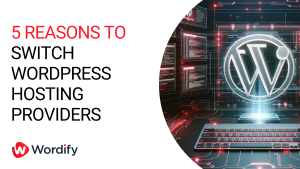
What is a WAF and How Does it Protect WordPress?
So what exactly is a WAF, and why would I want one?
To understand WAFs (Web Application Firewall) we need to go on a little journey through technical history (I know, I know, we’ll make it as painless as possible) to understand the Firewall and why the evolution to a WAF came about.
In the beginning there were Firewalls
The first versions of firewalls were very simple (and expensive) beasts that controlled traffic at a network level only. What does that mean? Well, they basically said things like, this IP is ok, this IP isn’t. Beyond that, they could even look at the types of traffic (by port number) to say, ok sure, we’ll allow HTTPS to this server, but not FTP. They were simple but effective.
We still use these basic principles of packet filtering in today’s security solutions. Most cloud providers enforce this type of setup so that things like SSH aren’t open to the world.
When is a Firewall not enough?
As attacks become more and more sophisticated, it became apparent that only stopping network level traffic wouldn’t be enough.
Why? Well, take your WordPress site as an example. In a basic level of firewall, we allow HTTP (80) and HTTPS (443) into the site, and we shut out nearly everything else.
So we’re good, we’re safe right… right? Well no, not at all.
Let’s say you have an out-of-date plugin, and it has a security vulnerability that would let a would-be hacker send MySQL database commands to it, often called SQL injection. The hacker would send their exploited payload to the plugin via HTTPS.
But our firewall, has it got our back here? Well no, because the firewall only asks “is this HTTPS?” and it is, so come on through.
Enter the WAF: Your Site’s Smart Security Guard
This is where a Web Application Firewall (WAF) comes into play. Think of a WAF as a much smarter security guard. Instead of just checking if someone has a valid ticket to enter (like a traditional firewall), a WAF actually looks at what people are trying to do once they’re inside.
A WAF understands web traffic – it knows what normal WordPress requests look like, and more importantly, what malicious ones look like. When someone tries to access your site, the WAF analyzes their request in real-time, checking for suspicious patterns like:
– SQL injection attempts
– Cross-site scripting (XSS)
– File inclusion exploits
– Suspicious POST requests
– Known malware signatures
– Abnormal traffic patterns
How does a WAF protect your WordPress site?
Let’s break down a real-world example. Say someone tries to exploit a vulnerable contact form on your WordPress site. Here’s what happens:
1. The attacker sends a request that looks normal on the surface (it’s using HTTPS, after all)
2. But hidden in that request is malicious code trying to inject SQL commands
3. The WAF inspects the content of the request
4. It recognizes patterns that match known SQL injection attempts
5. The request is blocked before it ever reaches your WordPress site
The best part? This all happens automatically and in real-time. You don’t need to be a security expert or constantly monitor your site – the WAF does that for you.
Why WordPress sites need a WAF
WordPress powers over 40% of all websites on the internet. That’s amazing, but it also makes WordPress sites a prime target for attackers. Here’s why a WAF is particularly important for WordPress:
1. Plugin Vulnerabilities: WordPress sites often use multiple plugins, each potentially introducing security risks. A WAF adds an extra layer of protection even if a plugin has an unknown vulnerability.
2. Zero-Day Protection: Even if a new type of attack is discovered, WAFs can often detect and block suspicious behavior before patches are available.
3. Brute Force Prevention: WAFs can detect and block repeated login attempts, protecting your wp-admin area.
4. Resource Protection: By blocking malicious requests before they reach your site, a WAF helps maintain your site’s performance and uptime.
Setting Up WAF Protection
Getting WAF protection for your WordPress site doesn’t have to be complicated. Many modern hosting providers, including Wordify, include WAF protection as part of their managed WordPress hosting solutions. The key is making sure your WAF is:
– Regularly updated with the latest threat signatures
– Configured specifically for WordPress
– Monitored and maintained by security experts
– Backed by robust infrastructure
Look for hosting providers that make security a priority and include WAF protection as a standard feature rather than an expensive add-on. This approach ensures you’re protected from day one, without needing to become a security expert yourself.
Conclusion
In today’s digital landscape, having a WAF isn’t just nice to have – it’s become a necessary layer of security for any WordPress site. While traditional firewalls still play an important role in security, a WAF provides that crucial extra layer of protection that modern websites need.
Remember, security isn’t about having a single solution – it’s about having multiple layers of protection working together. A WAF is a critical part of that security stack, working alongside regular updates, strong passwords, and good security practices to keep your WordPress site safe and secure.
Stay safe!

